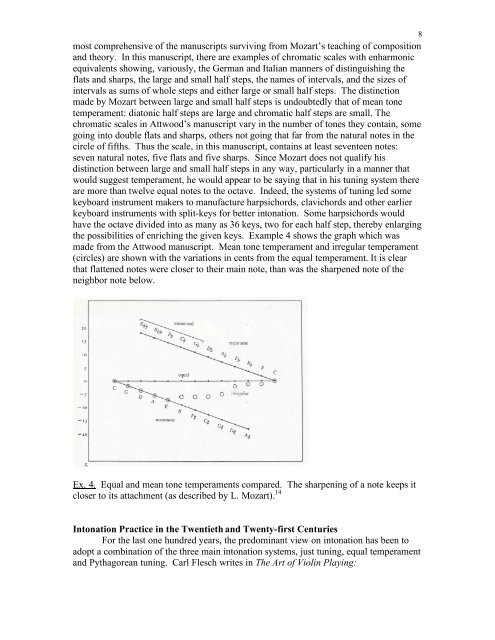A History of String Intonation - Borup, Hasse
A History of String Intonation - Borup, Hasse
A History of String Intonation - Borup, Hasse
Create successful ePaper yourself
Turn your PDF publications into a flip-book with our unique Google optimized e-Paper software.
8<br />
most comprehensive <strong>of</strong> the manuscripts surviving from Mozart’s teaching <strong>of</strong> composition<br />
and theory. In this manuscript, there are examples <strong>of</strong> chromatic scales with enharmonic<br />
equivalents showing, variously, the German and Italian manners <strong>of</strong> distinguishing the<br />
flats and sharps, the large and small half steps, the names <strong>of</strong> intervals, and the sizes <strong>of</strong><br />
intervals as sums <strong>of</strong> whole steps and either large or small half steps. The distinction<br />
made by Mozart between large and small half steps is undoubtedly that <strong>of</strong> mean tone<br />
temperament: diatonic half steps are large and chromatic half steps are small. The<br />
chromatic scales in Attwood’s manuscript vary in the number <strong>of</strong> tones they contain, some<br />
going into double flats and sharps, others not going that far from the natural notes in the<br />
circle <strong>of</strong> fifths. Thus the scale, in this manuscript, contains at least seventeen notes:<br />
seven natural notes, five flats and five sharps. Since Mozart does not qualify his<br />
distinction between large and small half steps in any way, particularly in a manner that<br />
would suggest temperament, he would appear to be saying that in his tuning system there<br />
are more than twelve equal notes to the octave. Indeed, the systems <strong>of</strong> tuning led some<br />
keyboard instrument makers to manufacture harpsichords, clavichords and other earlier<br />
keyboard instruments with split-keys for better intonation. Some harpsichords would<br />
have the octave divided into as many as 36 keys, two for each half step, thereby enlarging<br />
the possibilities <strong>of</strong> enriching the given keys. Example 4 shows the graph which was<br />
made from the Attwood manuscript. Mean tone temperament and irregular temperament<br />
(circles) are shown with the variations in cents from the equal temperament. It is clear<br />
that flattened notes were closer to their main note, than was the sharpened note <strong>of</strong> the<br />
neighbor note below.<br />
Ex. 4. Equal and mean tone temperaments compared. The sharpening <strong>of</strong> a note keeps it<br />
closer to its attachment (as described by L. Mozart). 14<br />
<strong>Intonation</strong> Practice in the Twentieth and Twenty-first Centuries<br />
For the last one hundred years, the predominant view on intonation has been to<br />
adopt a combination <strong>of</strong> the three main intonation systems, just tuning, equal temperament<br />
and Pythagorean tuning. Carl Flesch writes in The Art <strong>of</strong> Violin Playing:



